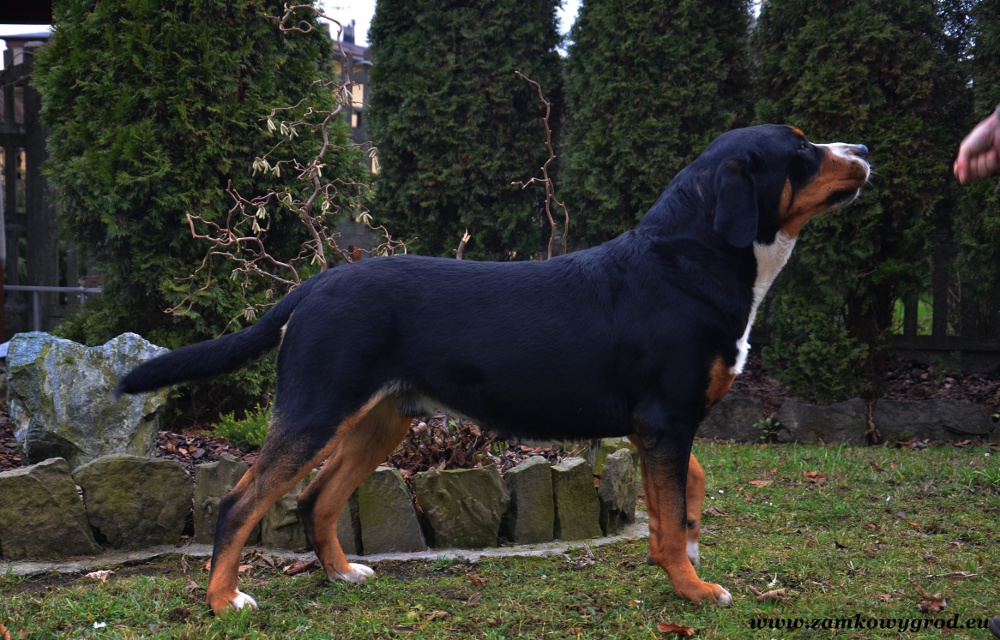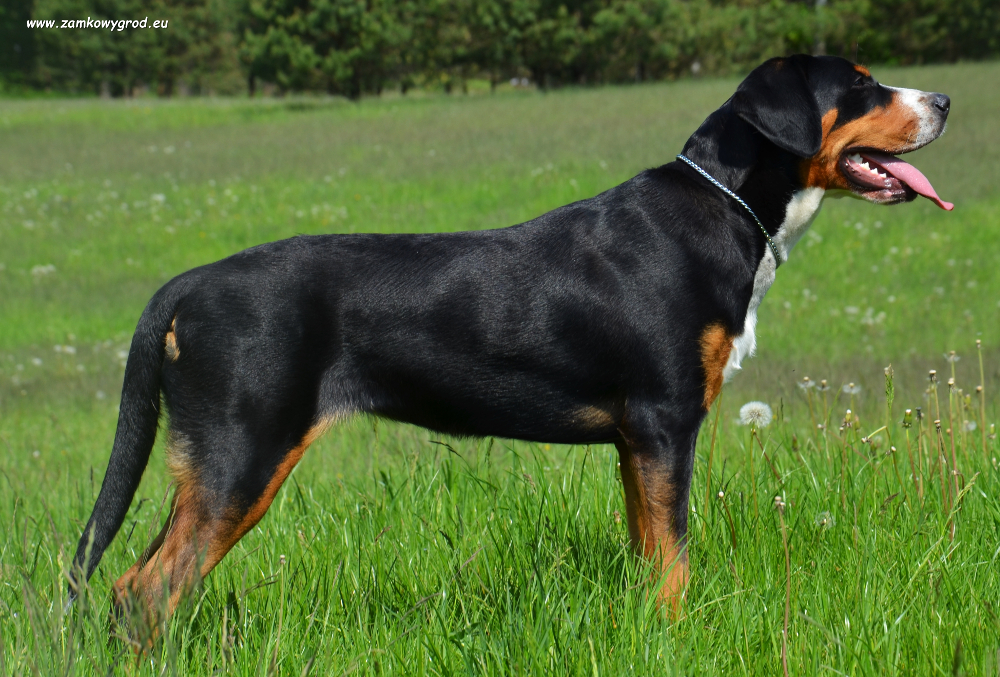our breed
Great Swiss Mountain DogAbout Breed
Great Swiss Mountain Dog
Great Swiss Mountain Dog is mainly excellent familiar dog. These dogs are gentle, calm, very loyal and warm friend of family. Despite its size and strength they love some stroking, cuddling and all evidence of our love. They are not indispensable companion of its owner every day. They are perfect partners for children of all ages – in that kind of contacts they are patient, very tolerant – they even let pull on the ear, very sensitive and what’s very important – they have sense of strenght.
Great Swiss Mountain Dog is guradian of home’ fire and very tender, too. They always are ready to stay in defense of family, they know no fear and they aren’t agressive.
They look commands respect. What they do when they see intruder? Firstly, dog will growl him, later will bark. They rarely don’t bite, cause at the beginning he or she warn. However, like each dog, they like rest and they sleep a lot because they stay vigilantly. These dogs aren’t sickly. They are resistant to various weather conditions. They don’t mind snow and frost. During hot days they feel good in shadow of the sun. This isn’t demanding grooming because they have short fur. This is excellent dog for you!
Breed
FCI-Standard N°58
GREAT SWISS MOUNTAIN DOG
(Grosser Schweizer Sennenhund, Great Swiss Mountain Dog)
ORIGIN: Switzerland
UTILIZATION : Originally watch- and draught dog. Nowadays also companion, guard- and family dog.
CLASSIFICATION F.C.I. : Group 2 Pinscher and Schnauzer – Molossoid breeds. Section 3 Swiss Mountain- and Cattle Dogs. Without working trial.

BRIEF HISTORICAL SUMMARY:
In 1908, at Langenthal, on the occasion of the jubilee show to mark 25 years of existence of the “Schweizerische Kynologische Gesellschaft” (Swiss Kennel Club) SKG, two short-haired Bernese Mountain Dogs were presented to the great promotor of the Swiss Mountain Dogs, Prof. Albert Heim. He recognized them to be representatives of the old, vanishing, large Mountain Dog or butcher’s dog, whose ancestors had in the past been widely spread across Europe, bred as guard-, draught- or droving-cattle dogs.
In 1909 they were recognized by the SKG as a separate breed being registered in volume 12 of the Swiss Stud Book. In 1912, the club for “Grosse Schweizer Sennenhunde” was founded in order to promote this breed and keep it purebred. The first standard was published by the FCI not before February 5th, 1939. Today these dogs are also bred in other European countries, they are especially appreciated as family dogs due to their calm, reliable temperament.
GENERAL APPEARANCE
IMPORTANT PROPORTIONS
Depth of chest to height at withers = 1 : 2
Length of skull to length of muzzle = 1 : 1
Width of skull to width of muzzle = 2 : 1
BEHAVIOUR/TEMPERAMENT
HEAD
CRANIAL REGION
Stop : Hardly pronounced.
FACIAL REGION
Muzzle : Strong, longer than its depth. Must not be pointed, seen either from above or in profile. Nasal bridge straight, without furrow.
Lips : Barely developed, well fitting. Black pigmentation. Not pendulous.
Jaw/Teeth : Strong jaws; complete, strong and regular scissor bite. The absence of two teeth (premolar 1 and/or premolar 2) is tolerated. Absence of the molars 3 (M3) is not taken into account.
Eyes : Almond-shaped, of medium size, neither deep set nor protruding. Hazel to chestnut brown, with alert, friendly expression. Lids close fitting. Eye rims dark.
Ears : Of medium size, triangular and set on fairly high. In repose hanging flat and close to the cheeks, but raised forward when attentive. Well covered with hair, both inside and outside.
NECK
BODY
Back : Moderately long, strong and straight.
Loins : Broad and well muscled.
Croup : Long and broad. Gently sloping. Never higher than the withers or abruptly slanting.
Chest : Strong, broad, reaching to the elbows. Seen in cross section, the ribcage is roundish oval shaped, neither flat nor barrel-shaped. Forechest well developed.
Belly and underline : Belly and flanks barely tucked up.
TAIL
LIMBS
Shoulders : Shoulder blade long, strong, well laid back, close-fitting to the body and well muscled, forming a not too obtuse angle with the upper arm.
Forearm : Heavy boned and straight.
Pasterns : Firm, seen from the front in straight line with the forearm; seen from the side almost vertical.
HINDQUARTERS : Straight and not too close when seen from the back. Metatarsus and feet turning neither in nor out. Dewclaws must be removed except in countries where their removal is forbidden by law.
Upper thigh : Fairly long, broad, strong and well muscled.
Stifle : Forming a distinctly obtuse angle.
Lower thigh : Fairly long.
Hock : Strong and well angulated.
FEET : Strong, pointing straight ahead, with well-knit, well arched toes and strong nails.
GAIT/MOVEMENT
COAT
COLOUR : Typically tricolour. Main colour black with symmetrical, reddish-brown (tan) markings and clean white markings. The reddish-brown colour is situated between the black and the white markings on the cheeks, above the eyes, on the inside of the ears, on both sides of the forechest, on all four legs and underneath the tail. The white markings are on the head (blaze and muzzle), running down unbroken from the throat to the chest, also on the feet and the tip of the tail. Between the blaze and the reddish-brown markings above the eyes, a band of black should remain. A white patch on the neck or a white collar around the neck are tolerated.
SIZE
Height at withers for bitches : 60 – 68 cm
FAULTS
– Unreliable behaviour.
– Absence of any teeth other than 2 PM1 and /or PM2 (Premolar 1 or 2). The M3 are not taken into account. Level bite.
– Light eyes. Lids not close fitting.
– Coat : Visible yellow-brownish or light grey undercoat.
Colour and markings not clear.
MISMARKING
– White marking on muzzle reaching distinctly beyond the corners of the mouth.
– White pasterns or hocks (“boots”) reaching beyond the pastern joints or hock joints.
– Noticeably asymmetrical markings.
ELIMINATING FAULTS
– Over- or undershot mouth, wry mouth.
– Entropion, ectropion.
– One or two blue eyes (Wall eye).
– Short coat without undercoat.
– Long coat.
– Other than tricolour coat.
– Main colour other than black.
Any dog clearly showing physical or behavioural abnormalities shall be disqualified.
Our dogs
ATLAS Sennenhund Estate
Mother: Gran Vencedor CASUALE
Father: Sennenhund Rossii HUNTER
ARIA z Lisowskiego Wzgórza
Mother: JULIA Złota Nimfa
Father: ELMIR Alpiyskaya Semya

Litters

Puppies
More information coming soon 🙂 We expect puppies on August 2019!
Breeding "Z Zamkowego Grodu"

+48 515 186 836



